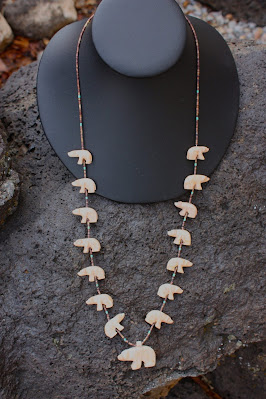Things to Know About Fetish Jewelry
Fetish jewelry is a distinctive style of craftsmanship from the Native Americans. The indigenous artisans have been crafting these unique designs inspired by the spiritual beliefs, their legends, and nature. Each unique native tribe from the northeast to the southwest has its specific jewelry style that sets them apart. Since the time of the Maya, Aztec, Inca, and the Anasazi, pieces are remnants of history. The Native American tribes nowadays make beautiful pieces of fetish jewelry (such as Zuni fetish necklace) with modern materials like titanium and gold. Apart from shells, stones, and bones, most Native Americans used turquoise as a building material. It is a widely revered material in many cultures around the world and had great economic and symbolic value in Native American culture. Jewelry played a vital part in economic trade and ceremonial purposes.
What are Zuni Fetishes?The Zuni fetishes are symbolic and
ceremonial jewelry pieces created with carved stones, fossils, and shells. The
pieces often depict iconic cultural scenes and animals. This jewelry is often
collected by art enthusiasts worldwide. Hence, its price can be on the higher
side. These pieces are made by several Native American tribes like the Pueblo,
Navajo, Hopi, and the Kewa Pueblo. Most of the designs even suit the
contemporary lifestyle hence;, they are very popular across all age groups.
Zuni Fetishes and their religious connotation
According to the Zuni people, the world
is divided into six directions or regions. The north, west, east, south, down,
and above each have a great mountain peak at the center. This sacred place is the black mountain
below, the multicolored mountain above, the White Mountain to the east, the red
mountain to the south, the blue mountain to the west, and the north's yellow
mountain. A Prey God represents the
directions. Often they depict an animal guardian and are also elaborated in the
jewelry as follows-
·
West is represented by the black bear (in color blue),
·
A white wolf represents East,
·
above or the sky is represented by a multicolored eagle,
·
below or underground is represented by a black shrew
·
A yellow mountain lion
·
represents North
·
A red badger represents South,
Each prey god is regarded as the
guardian of that specific region. It is the master of all spiritual and natural
entities in that specific region. Whenever there is an illness or natural
calamities, the priests always call upon the prey god of that region to protect
people through the hard times. These prey gods are symbolic of strength and
protection hence often depicted beautifully in fetish jewelry such as the zuni fetish necklace. Generally, the jewelry
of a particular region will showcase more representation of their respective prey
gods.
Another group of fetishes is often the
Prey Gods of the Hunt. Here only two animals replace the original
representatives of the prey gods. The wildcat replaces the red badger, and the
coyote replaces the bear. They are also called upon in the "Sa- ni- a-
Kia" in the prayer songs. These guardian animals play a vital role in the
religious and cultural ceremonies of the Native tribes. Hence the fetish
jewelry is heavily influenced by them. Most of the jewelry will have some or
the other way to glorify a hunter or prey god's magnanimity.
Other animals typically depicted in
the Zuni Fetishes are deer, moles, wolf, mountain lion, etc. Many contemporary
carvers also depict unorthodox images of exotic creatures like certain insects
or reptiles and even dinosaurs. These animals like chameleons, butterflies, dragonflies,
and water spiders are symbolic and often inspired by the petroglyphs. Although
the Zuni culture is devoid of horse rearing, many northern tribes still
exercised great power due to their control over huge herds of animals,
including horses. Hence, many jewelry pieces will also have horses engraved in
them, although it’s not traditionally carved.
Materials used for creating Zuni Fetish Necklace
Most of the materials used are locally
sourced. Historically carvers also used items procured from pilgrimages and
trade. But the most prized and sought after material used
for making jewelry was turquoise. It is also regarded as sacred and often
auspicious to wear turquoise. Other materials frequently used were corals, shells
specifically mother of pearl and jet. The most iconic image in the Zuni fetish
jewelry is the “sun face." The different colored stones and materials were
often used to adorn the image of the Sun, which is regarded as the father
figure.
Some of the other naturally sourced
materials used are- elf or deer antler, travertine or "Zuni Rock",
fossilized ivory, bones, marble, pipestone, and fish rock. Some of the real old
pieces were created with serpentine, which is a local soft stone found
specifically in Arizona and in the Zuni Mountains. To cater to modern
customers' needs, the Zuni artist has also incorporated the use of artificial
materials like slag glass. All sorts of materials are used nowadays to create
stunning jewelry pieces to please the aesthetic needs of a large variety of
customers.
The authenticity of Zuni Fetish Jewelry
Many people prefer a more realistic
and well carved out feature in their Zuni Fetish jewelry. But the customarily
Zuni perspective is to make a minimal alteration to the original building
materials. However, it will also depend on the perception of realism of the
carver how intricate the design he/she wants to make. If you are looking for any
marks by the carver for identification, then the Zuni community forbids it.
Authentic Zuni fetish jewelry will have no signs of personalization as this
violates the community rules. The jewelry might have the carver's unique style
that will make it identifiable, but most of the skills are part of the legacy
passed through generations. Most authentic carvers never leave their native places
and are blessed by a Medicine Man or Shaman before they create a piece.




Comments
Post a Comment